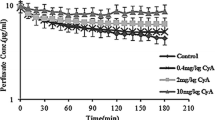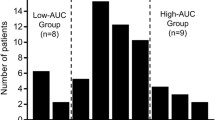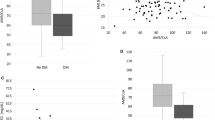Summary
Ten patients with orthotopic liver transplants were investigated during routine therapeutic monitoring to study the relationship between the concentrations of cyclosporin and its metabolites in blood, bile and urine, and whether this information can provide early signs of severe hepatic disorders post-transplantation. Cyclosporin (Sandimmun®) was administered by continuous infusion at a constant rate of 5 mg/kg/day, modified to keep the blood cyclosporin concentration within the target range (400 to 500 μg/L). The concentrations of cyclosporin and combined cyclosporin-metabolites in blood, bile and urine were assayed daily during the 3 post-transplantation weeks that the patients spent in intensive care.
All patients developed cholestatis and cytolysis during the first week. The severity of these liver transplant disorders increased in 5 patients and decreased in the other 5 in the second week. The pharmacokinetics of cyclosporin differed in the 2 groups: in patients without severe hepatic disorders, the blood metabolites/cyclosporin ratio (M/C) stabilised at 1.2 ± 0.4 in week 2 and at 0.8 ± 0.2 in week 3, bile cyclosporin/blood cyclosporin (bile C/blood C) fluctuated around 13.5 (13.5 ± 9.5 in week 2 and 13.5 ± 9.0 in week 3) and the bile metabolite/blood metabolite (bile M/blood M) ratio was very high and variable (131 ± 86 in week 2 and 159 ± 116 in week 3). Metabolites significantly accumulated in the blood of patients with severe hepatic disorders (M/C = 2.8 ± 0.6 in week 2 and 3.5 ± 1.0 in week 3); bile C/blood C (2.6 ± 2.1 in week 2 and 3.4 ± 1.1 in week 3) and bile M/blood M (11.9 ± 7.8 in week 2 and 12.5 ± 7.9 in week 3) significantly decreased and showed less interindividual variability.
Blood cyclosporin is usually monitored to help optimise the dosage. However, if this was extended to include the monitoring of metabolites in the blood, and cyclosporin and metabolites in the bile, it could provide an early indication of severe hepatic disorders in patients with transplanted livers.
Similar content being viewed by others
References
Faulds D, Goa KL, Benfield P. Cyclosporin - a review of its pharmacodynamic and pharmacokinetic properties, and therapeutic use in immunoregulatory disorders. Drugs 1993; 45: 953–1040
Patchcinski RJ, Venkataramanan R, Burckart GJ. Clinical pharmacokinetics of cyclosporin. Clin Pharmacokinet 1986; 11: 107–32
Lindholm A. Factors influencing the pharmacokinetics of cyclosporine in man. Ther Drug Monit 1991; 13: 465–77
Rodighiero V. Therapeutic drug monitoring of cyclosporin. Practical applications and limitations. Clin Pharmacokinet 1989; 13: 27–37
Awni WM, Heim-Duthoy KL, Kasiske BL. Therapeutic monitoring of cyclosporine by using pharmacokinetic studies. Clin Chem 1991; 37: 1891–2
Christians U, Sewing KF. Cyclosporin metabolism in transplant patients. Pharmacol Ther 1993; 57: 291–345
Woo J. Therapeutic monitoring of cyclosporine. Ann Clin Lab Sci 1994; 24: 60–8
Wang P, Meucci V, Simpson E, et al. A monoclonal antibody fluorescent polarisation immunoassay for cyclosporine. Transplant Proc 1990; 22: 1186–8
Schroeder TJ, Pesce AJ, Hindenlang LL, et al. An evaluation of the cyclosporine and metabolites whole blood TDx assay. Ther Drug Monit 1989; 11: 480–2
Rosenlof L, Sawyer RG, Broccoli T. Monoethylglycinexylidine (MEGX) and the utilization of hepatic donors for transplantation. Proceedings of the XlVth International Congress of the Transplantation Society, Paris, 1992 August 16-21
Azoulay D, Adam R, Astarcioglu I, et al. Limits of the MEGX test for selection of liver grafts. Proceedings of the XIVth International Congress of the Transplantation Society, Paris 1992 August 16-21
Christians U, Kohlhaw K, Budniak J, et al. Ciclosporin metabolite pattern in blood and urine of liver graft recipients. Eur J Clin Pharmacol 1991; 41: 291–6
Degroen PC. Cyclosporine and the liver: how one affects the other. Transplant Proc 1990; 22: 1197–202
Christians U, Kohlhaw K, Surig T, et al. Parallel blood concentrations of second generation cyclosporine metabolites and bilirubin in liver graft recipients. Ther Drug Monit 1995; 17: 487–98
Kahan BD, Shaw LM, Grevel J, et al. Consensus document: Hawks Coy meeting on therapeutic drug monitoring of cyclosporin. Clin Chem 1990; 36: 1510–16
Beukers R, De Rave S, Van Der Berg JWO, et al. Oral pharmacokinetics of cyclosporin in patients with primary biliary cirrhosis and patients with skin diseases. Aliment Pharmacol Ther 1992; 6: 459–68
Robson S, Neuberger J, Keller HP, et al. Pharmacokinetic study of cyclosporin A (Sandimmun®) in patients with primary biliary cirrhosis. Br J Clin Pharmacol 1984; 18: 627–31
Jain AB, Gunson BK, Buckels JAC, et al. Is elimination of cyclosporine in bile dependent on liver graft function and biliary drainage? Transplant Proc 1988; 2: 516–22
Beveridge T. Pharmacokinetics and metabolism of cyclosporin A. In: White DJG, editor. Cyclosporin A. New York: Elsevier Biomedical, 1982: 5–17
Bleck JS, Schlitt HJ, Christians U, et al. Ciclosporin metabolic pattern in relation to liver function. Eur J Clin Pharmacol 1991; 40: 565–9
Author information
Authors and Affiliations
Rights and permissions
About this article
Cite this article
Debruyne, D., Samba, D., Lacotte, J. et al. Bile and Blood Ratios of Cyclosporin and its Metabolites in Patients on Continuous Infusion During the First Three Weeks after Liver Transplantation. Clinical Drug Investigation 12, 67–79 (1996). https://doi.org/10.2165/00044011-199612020-00002
Published:
Issue Date:
DOI: https://doi.org/10.2165/00044011-199612020-00002




